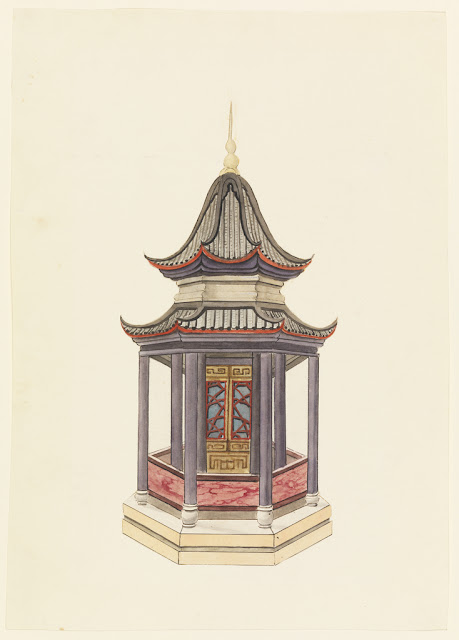 |
| Frederick Crace Design for Chinese pavilion ca. 1815-22 watercolor Cooper Hewitt, Smithsonian Design Museum |
 |
| Frederick Crace Design for Chinese pavilion ca. 1815-22 watercolor Cooper Hewitt, Smithsonian Design Museum |
 |
| Frederick Crace Design for Chinese pavilion ca. 1815-22 watercolor Cooper Hewitt, Smithsonian Design Museum |
"Throughout the nineteenth century, the arts of China and Japan were an inexhaustible source for design ideas. Chinoiserie, a pseudo-Chinese decorative style popularized by Europeans in the 1730s, reappeared during the Regency and continued into the nineteenth century."
"European interest in non-Western art was first stimulated by trade with the East in the sixteenth and seventeenth centuries. By the nineteenth century, with the advent of the railroad and steamship, lands that were little known to Westerners became easier to access. As more Europeans traveled beyond the established routes of the Grand Tour, their experiences abroad began to influence their tastes at home. Other influences were a result of England's massive imperial control over lands in China, India, Africa and the Pacific. By mid-century, many non-Western forms and ornamental motifs had found their way into the vocabulary of the European decorative arts."
"Like Orientalist subjects in nineteenth-century painting, exoticism in the decorative arts and interior decoration was associated with fantasies of opulence and "barbaric splendour," in the words of the English explorer, linguist, and writer, Sir Richard F. Burton (1821-1890). The arts of the East were also considered quaint and uncorrupted by industrial capitalism. While English critics complained about the lack of integrity and poor design in the utilitarian goods that were being produced in their factories, they exalted the preindustrialized nations and held them in great esteem as examples of good design."
"By the end of the century, the exotic, as appropriated by the West, had become a mass-produced commodity in itself; exotic images were used to sell everything from cigarettes to candy. However, the exotic continued to influence the appearance of the decorative arts as it fused with the organic whiplash curves of the avant-garde style known as Art Nouveau."
– excerpted from Exoticism in the Decorative Arts by Sara J. Oshinsky, an essay from the Heilbrunn Timeline of Art History at the Metropolitan Museum, New York
 |
| Frederick Crace Design for Chinese pavilion ca. 1815-22 watercolor Cooper Hewitt, Smithsonian Design Museum |
 |
| Frederick Crace Design for Chinese pavilion ca. 1815-22 watercolor Cooper Hewitt, Smithsonian Design Museum |
 |
| Frederick Crace Design for Chinese pavilion ca. 1815-22 watercolor Cooper Hewitt, Smithsonian Design Museum |
 |
| Frederick Crace Design for Chinese pavilion ca. 1815-22 watercolor Cooper Hewitt, Smithsonian Design Museum |
 |
| Frederick Crace Design for Chinese pavilion ca. 1815-22 watercolor Cooper Hewitt, Smithsonian Design Museum |
 |
| Frederick Crace Design for Chinese pavilion ca. 1815-22 watercolor Cooper Hewitt, Smithsonian Design Museum |
 |
| Frederick Crace Design for Chinese pavilion ca. 1815-22 watercolor Cooper Hewitt, Smithsonian Design Museum |
 |
| Frederick Crace The Fishing Temple, Virginia Water, in the form of a Chinese Pavilion ca. 1818-19 drawing Cooper Hewitt, Smithsonian Design Museum |
 |
| Frederick Crace The Fishing Temple, Virginia Water, in the form of a Chinese Pavilion ca. 1825 watercolor, gouache Cooper Hewitt, Smithsonian Design Museum |
George IV built the "Fishing Temple" on a lake in Windsor Park during the 1820s. In 1867 Queen Victoria converted it into a "Swiss Cottage." This was demolished in 1936.